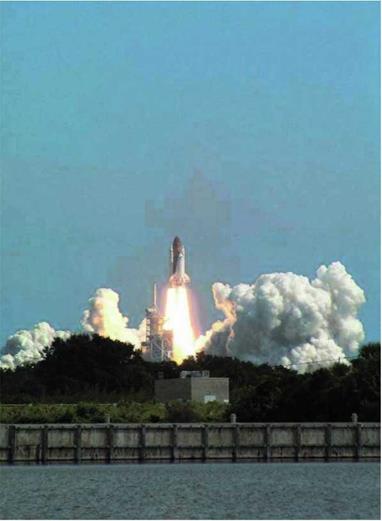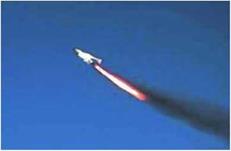Propellants
The force that causes a rocket engine’s thrust results from combustion. This type of chemical reaction is similar to burning wood. The wood, which is a fuel, and the air, which is an oxidizer, react to form gases and other substances. Both the fuel and oxidizer must be present for combustion to occur.
The difference with a rocket engine is that the fuel and the oxidizer release much higher energy, and the gases from the reaction travel out of the nozzle at very high speeds. These high-speed gases provide the thrust.
Each Space Shuttle SRB contains 1,100,000 pounds (500,000 kilograms) of solid propellant, 70 percent ammonium perchlorate for its oxidizer and 16 percent aluminum powder for its fuel. The balance consists of binders, curing agents, and catalysts. These burn until there is nothing left to burn. The liquid propellants are contained in separate pressurized tanks within the ET. These tanks hold 1,350,000 pounds (612,000 kilograms) of liquid oxygen oxidizer, often called LOX, and 227,800 pounds (103,000 kilograms) of liquid hydrogen fuel. The main engines produce thrust when the liquid oxygen and liquid hydrogen are pumped together.

 |
C >
Fig. 5.3. To reach orbit, the Space Shuttle uses three liquid-fueled rocket engines, the shuttle main engines (SME) at the rear of the orbiter and two solid rocket boosters (SRB), which are attached to the external tank (ET). Dan Linehan
V_________________ )
SpaceShipOne is a tiny fraction of the Space Shuttle’s mass, and it reaches less than a third of the height the Space Shuttles does. So, the propellant requirements are quite different. SpaceShipOne used nitrous oxide (N20), a colorless liquid or gas naturally occurring in the atmosphere. Nitrous oxide is commonly used as laughing gas, as a hot rod fuel additive for a quick boost of speed, and as a propellant for whipped cream. The N20 is liquefied and used as the oxidizer. The oxidizer enables the fuel to burn at a near-explosive rate. The oxidizer tank contains 3,000 pounds (1,360 kilograms) of N20.
г ^
Fig. 5.4. When the oxidizer and the fuel combine, a vigorous chemical
reaction takes place. The very hot gases from this combustion produce the thrust and resulting fiery plume. Mojave Aerospace Ventures LLC, photo provided courtesy of Discovery Channel and Vulcan Productions, Inc.
Hydroxyl-terminated polybutadiene (HTPB) is the solid used for the fuel and is a synthetic rubber, like that used to make tires. About 600 pounds (270 kilograms) fuel the rocket engine. Both the oxidizer and the fuel can easily and safely be stored and transported. In fact, unlike liquid oxygen and liquid hydrogen, which react together spontaneously, N20 and HTPB will not react together unless an igniter is first used. For the reaction to occur, the temperature must be greater than 570 degrees Fahrenheit.
The combustion products from the combination of N20 and HTPB are mostly carbon dioxide, carbon monoxide, hydrogen, nitrogen, and water vapor. This is not as clean burning as the Space Shuttle’s main engines but is much less polluting than the Space Shuttle’s solid rocket boosters, which produce a giant, toxic acid cloud. Figure 5.3 and figure 5.4 show the rocket engines of the Space Shuttle and SpaceShipOne firing, respectively.










